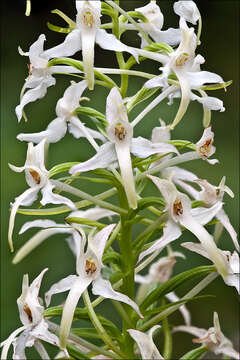Platanthera-bifolia-ssp-bifolia_51

Description:
Platanthera bifolia ssp. bifolia (L.) Rich., syn.: Orchis bifolia L.Lesser Butterfly-orchid, DE: Weie Waldhyazinthe, Zweiblttriges BreitklbchenSlo.: dvolistni vimenjakDat.: June 18. 2015Lat.: 46.36653 Long.: 13.72440Code: Bot_888/2015_IMG8334Picture file names: from Platanthera-bifolia-ssp-bifolia_raw_50 to Platanthera-bifolia-ssp-bifolia_raw_68.Habitat: light mixed forest, Picea abies, Fagus sylvatica dominant; moderately inclined mountain slope, northwest aspect; calcareous, colluvial, stony ground; quite humid place; mostly in half shade; mostly exposed to direct rain; elevation 565 m (1.850 feet); average precipitations ~ 3.000 mm/year, average temperature 7-9 deg C, alpine phytogeographical region. Place: Lower Trenta valley, left bank of river Soa between villages Trenta and Soa, downstream of farmhouse Maselc, East Julian Alps, Posoje, Slovenia EC.Comment: Platanthera bifolia ssp. bifolia is a beautiful, gracious and quite common wild orchid of Trenta valley. At the place of this observation there were more than hundred blooming plants present on a relative small place. The plant is a wide spread species and grows in the whole alpine belt and other European mountains including Pyrenees and Carpathians. It is very similar to his sister Greater Butterfly-orchid (Platanthera chlorantha), which has more greenish flowers but very similar habitus and sometimes builds hybrids with Platanthera bifolia ssp. bifolia, where they grow together. In such cases it is not always easy to determine properly plants found. The most reliable distinguishing trait of both species is position of their pollinia (see picture Platanthera-bifolia-plus-chlorantha_1). With Platanthera bifolia ssp. bifolia (left) they are parallel and close together. The entrance to spur is sometimes hard to see. Contrary, with Platanthera chlorantha (right) pollinia are divergent and widely separated. The entrance to spur is clearly visible. Both plants have unusually long and slender spur. Only certain night-flying moths have long enough proboscis to be able to reach nectar at the bottom of the long spur.Canon G11, 6.1-30mm/f2.8-4.5Protected according to: Uredba o zavarovanih prostoiveih rastlinskih vrstah, poglavje A, Uradni list RS, t. 46/2004 (Regulation of protected wild plants, chapter A, Official Gazette of Republic Slovenia, no. 46/2004), (2004).According to Pravilnik o uvrstitvi ogroenih rastlinskih in ivalskih vrst v rdei seznam, Uradni list RS, t. 82/2002 (Regulation of enlisting of endangered plant and animal species onto Red List, Official Gazette of Republic Slovenia, no. 82/2002) (2002) enlisted in the Slovene Red List of rare and endangered species, marked by "V" representing a vulnerable species.Ref.:(1) H.Baumann, S. Kuenkele, R.Lorenz, Orchideen Europas, Ulmer (2006), p 259.(2) B.Dolinar, Kukavievke v Sloveniji (Orchidaceae of Slovenia) (in Slovenian), Pipinova Knjiga (2015), p 157.(3) B.Allan, P. Woods, S. Klark, Wild Orchids of Scotland, HMSO, Edinburgh (1996), p 82.(4) D. Aeschimann, K. Lauber, D.M. Moser, J.P. Theurillat, Flora Alpina, Vol. 2., Haupt (2004), p 1110.(5) H.Kretzschmar, Die Orchideen Deutschlands und angrenzenden Lander, Quelle Meyer (2008), p 226.
Included On The Following Pages:
- Life (creatures)
- Cellular (cellular organisms)
- Eukaryota (eukaryotes)
- Archaeplastida (plants)
- Chloroplastida (green plants)
- Streptophyta
- Embryophytes
- Tracheophyta (ferns)
- Spermatophytes (seed plants)
- Angiosperms (Dicotyledons)
- Monocots (Monocotyledons)
- Asparagales
- Orchidaceae (orchids)
- Platanthera (Fringed orchids)
- Platanthera bifolia (lesser butterfly-orchid)
- Platanthera bifolia bifolia
This image is not featured in any collections.
Source Information
- license
- cc-by-nc-sa
- copyright
- Amadej Trnkoczy
- photographer
- Amadej Trnkoczy
- original
- original media file
- visit source
- partner site
- Flickr Group
- ID


